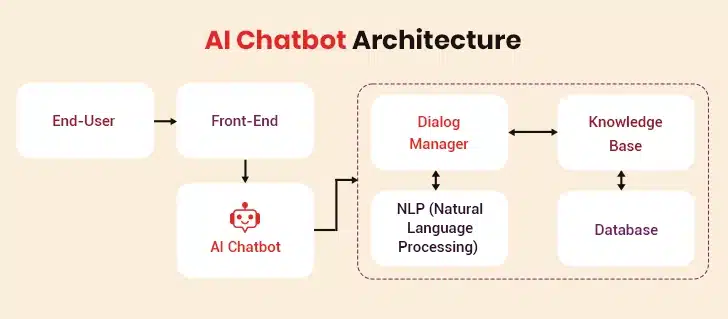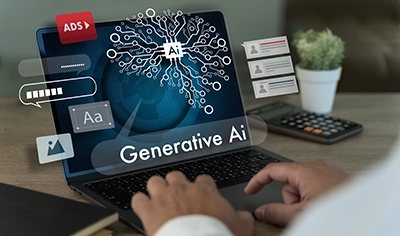Customer service has changed tremendously over the last decade. Customers now need instant, relevant answers from businesses. AI chatbots help solve this problem. They handle many more conversations than a human agent can. Today, when reliable customer service is essential to winning buyers, chatbots have become a vital investment.
What makes these AI bots so valuable? They use machine learning and natural language processing to enhance business interactions. They also offer round-the-clock support regardless of the time zone. This way, companies maintain consistent communications across all platforms while gathering valuable insights into customer behavior.
This blog talks about effective AI chatbot development. It also explores their architecture, examines implementation strategies, and shows how they boost both customer engagement and operational efficiency in today’s business landscape.

Table of Contents
How are AI Chatbots Transforming Industries
The Architecture Powering AI Chatbots
Building an AI-Powered Chatbot: A Step-by-Step Approach
Challenges and Considerations in Building AI Chatbots
The Anatomy of AI Chatbots
Businesses need to understand how virtual assistants work to make smart decisions about AI chatbot development. These tools have grown from simple scripted programs into sophisticated conversation partners that handle complex interactions.
1. What are AI Chatbots?
AI chatbots are software applications that simulate human-like conversations through text or voice interfaces. Modern AI-powered versions can interpret user intent and respond naturally. This way, they differ from traditional chatbots that use rigid scripts.
Every AI chatbot has these essential components:
- Input Processing: Receives and interprets user queries
- Intent Recognition: Identifies what the user wants to accomplish
- Response Generation: Creates appropriate replies based on the identified intent
- Learning Mechanism: Improves responses over time
These intelligent systems work on websites, messaging platforms, and mobile applications of all types. They understand human language through sophisticated algorithms that analyze patterns, context, and semantic meaning to give relevant responses.
AI conversation bots excel at keeping context throughout chats. They remember previous exchanges to create coherent conversation threads. This ability turns simple question-answer exchanges into meaningful dialogs that feel like human conversations.
2. Types of AI Chatbots
The digital world of chatbot technology features several distinct categories. Each has its strengths and limitations:
- Rule-Based Chatbots: These chatbots follow pre-defined rules and decision trees that developer’s program. They perform well in structured scenarios with predictable questions. However, they face challenges with unexpected scenarios or queries. Rule-based systems respond to specific keywords in user input. This makes them easy to implement but less flexible.
- Machine Learning-Powered Chatbots: These chatbots use artificial intelligence to get better over time. They learn from data and user interactions instead of following rigid rules. Each conversation helps them understand the context better and generate more appropriate responses. These systems adapt to new scenarios without requiring explicit reprogramming.
- Hybrid Chatbots: Hybrid models combine rule-based structures with machine learning capabilities. They use predefined pathways for common scenarios and AI for complex queries. This approach ensures reliable performance for critical functions and allows adaptation and learning.
- Conversational AI Chatbots: Conversational AI chatbots are the most advanced category. These bots use sophisticated natural language processing to manage human-like exchanges. They understand context, remember chat history, and detect emotional nuances. They can handle unclear requests and understand slang.
Companies can choose between these categories based on their specific needs, available resources, and intended uses. Simple tasks work well with rule-based chatbots, while complex scenarios need sophisticated AI chatbots.
How are AI Chatbots Transforming Industries

AI-powered chatbots are making a measurable impact across industries. These digital assistants solve numerous business challenges. They also deliver a strong return on investment.
I. Customer Service and Support
Customer service remains the primary domain for chatbots. These systems handle routine questions with remarkable efficiency. Companies that use conversational chatbots improve their first-contact resolution rates. Besides, AI-based automation cuts wait times drastically: chatbots respond in under 5 seconds, while human agents take an average of 45 seconds.
These virtual assistants provide steady support regardless of the number of requests. AI customer service bots can handle thousands of conversations simultaneously during busy periods without any drop in quality. Human teams would need to augment their staff substantially to match this capability.
Organizations gain several advantages from these bots:
- 24/7 availability across time zones
- Consistent responses to common questions
- Smooth handoff to human agents when needed
- Multiple language support without extra staff costs
How Conversational AI Can Drive Better Customer Experience
II. Automation of Business Processes
AI conversation bots excel at streamlining internal operations. They handle everything from data entry to compliance documentation. This frees employees from doing repetitive work.
Finance teams use chatbots to process expense reports and check documentation, cutting processing time considerably. Likewise, HR departments employ these assistants to help new employees complete paperwork and understand company policies.
These bots also help with data collection. Users can share information through conversations instead of filling out complex forms. This leads to better completion rates and fewer mistakes.
III. Seamless Appointment Scheduling
AI chatbots have reshaped how appointment-based businesses work. Today, organizations see fewer no-shows, owing to their automated reminders and simple rescheduling options.
Professional services companies let AI chatbots handle client bookings automatically. These systems check availability, meeting length requirements, and user preferences before suggesting the best time slots.
The result? Businesses spend less time on administrative tasks while clients feel satisfied with instant booking confirmations and timely reminders.
IV. Virtual Assistants for Employee Productivity
AI chatbots also serve as personal productivity assistants. They help staff find resources, retrieve documents, and access information. No need to dig through complex databases or interrupt colleagues.
In large organizations, these assistants cut the time spent searching for information. They also improve knowledge sharing. Employees can ask questions in plain language instead of using rigid search terms.
Remote teams also benefit from AI conversation bots that keep information access consistent. This ensures off-site employees get the same support as those in the office.
The Architecture Powering AI Chatbots

AI chatbot development relies on several connected components that work together to create smart, responsive virtual assistants. These components create a sophisticated system that processes, understands, and responds to what humans say.
1. User Interface (UI): Bridging Human-Machine Interaction
The UI connects users with the AI system underneath. This visual layer includes all the interactive elements (e.g., message bubbles, input fields, buttons, and avatars) that make communication possible. A well-designed interface shows users exactly how to proceed at each step, guiding them through conversations without confusion. AI chatbots typically include:
- Clear welcome messages
- Quick-reply buttons that reduce typing effort
- Chat history access for reference
- Feedback mechanisms to improve responses
The way an interface looks shapes how users feel about it and affects how much they use it. Clean, accessible designs with appropriate color choices make more users adopt the technology.
2. Natural Language Processing (NLP): The Brain That Understands Human Language
NLP lets machines understand human language. It forms the foundation of smart chatbot conversations. NLP changes regular text into data the machine can use through several steps. These include:
- Tokenization: Breaking text into words
- Intent Recognition: Figuring out what users want
- Entity Extraction: Pulling out key information like dates or locations
Additionally, Natural Language Understanding (NLU) analyzes sentence structure, semantics, and context. Natural Language Generation (NLG) converts the chatbot’s answers into a language that sounds natural to humans.
3. Dialog Manager: Enabling Contextual Conversations
The dialog manager controls how conversations flow and keeps track of context. Unlike basic systems that just answer questions, this component remembers previous messages and creates coherent conversations.
It picks the right responses based on what’s happening now, what the user wants, and where the conversation stands at any point in time. The dialog manager also decides when to ask for clarity, give information, or let a human take over.
4. Machine Learning Models: Continuous Learning for Smarter Interactions
AI bots get better through machine learning algorithms that study conversation patterns. These models learn from past conversations and user feedback.
With each conversation, the models spot what works and what doesn’t. This learning process helps chatbots handle increasingly complex questions over time. No need to reprogram them. The more interactions they process, the more valuable they become.
5. Knowledge Base: The Foundation of Accurate Responses
The knowledge base holds all the information an AI bot can use to answer questions. This includes product details, policies, common questions, and step-by-step guides in organized formats.
The knowledge base holds all the information an AI bot can use to answer questions. This includes product details, policies, common questions, and step-by-step guides in organized formats.
The accuracy of responses depends on the quality of the knowledge base. Keeping an updated, organized knowledge base helps businesses deliver consistent, on-brand responses in every conversation.
Building an AI-Powered Chatbot: A Step-by-Step Approach
Building chatbots requires careful planning and execution. The AI development process involves many stages. These stages transform an idea into a functional solution that meets business needs.
I. Define Chatbot’s Purpose and Target Audience
AI chatbot development should start with a clear purpose. The bot could handle customer support, schedule appointments, or automate internal processes. A specific purpose defines the direction you need. It’s important to understand who will use your chatbot. This initial focus helps create solutions that match actual user needs. It also prevents the project from growing too complex.
II. Select a Suitable Development Platform and Tech Stack
The choice of platform impacts everything from development complexity to your bot’s capabilities. For building the bot, developers can choose code-based frameworks based on Python or JavaScript. They can also use Python’s powerful libraries, such as TensorFlow and Rasa.
The choice of platform impacts everything from development complexity to your bot’s capabilities. For building the bot, developers can choose code-based frameworks based on Python or JavaScript. They can also use Python’s powerful libraries, such as TensorFlow and Rasa.
For teams with little technical proficiency, no-code platforms are a good fit. These platforms provide drag-and-drop interfaces that speed up development. The choice should, ultimately, align with your team’s technical capabilities and integration requirements.
III. Design Conversation Flows and User Interface
A well-designed conversation flow creates the foundation of a successful AI bot. One should start by mapping key interaction paths, common questions, and expected responses. Well-planned dialog structures ensure your chatbot handles inquiries intuitively.
Besides, conversations can be organized into logical groups. Short messages can be used instead of walls of text to keep users engaged. The bot interface should make the next steps obvious with clear welcome messages and visual elements that guide the user.
IV. Integrate with External Data Sources
Chatbots with advanced features should be able to access external information systems. This way, they get real-time data related to customer accounts, transactions, or inventory. Bots can be connected to APIs, databases, or third-party services. These integrations enrich a bot’s responses. They also let the bot do more than just simple conversations.
V. Test and Refine Iteratively Before Deployment
It’s important not to rush to launch without thoroughly testing the bot in simulated environments. Start with the basics: focus on common questions to verify the accuracy of responses. Also, test how it handles multiple-question workflows and tricky situations where users might confuse the system. The most valuable feedback comes from user acceptance testing with actual end-users.
However, the work isn’t done even after the bot has been deployed. Teams need to track performance metrics regularly after the launch to guide future improvements.
Healthcare Company Achieves an 11% Boost in NPS Scores with AI Chatbot
Challenges and Considerations in Building AI Chatbots
AI chatbots bring substantial benefits. However, organizations face many challenges during their implementation. These can affect project success if they are not tackled properly.
1. Data Security Concerns
AI chatbots often handle sensitive information. This exposes organizations to risks such as data breaches or cyberattacks.
The decentralized nature of chatbots makes securing them especially tricky. Unlike traditional systems where security breaches follow predictable patterns, chatbot vulnerabilities can hide in plain sight without centralized oversight. Many times, employees share sensitive information unknowingly when they use AI tools. That is why companies like JPMorgan Chase, Verizon, and Amazon have restricted or completely banned their staff from using certain AI platforms.
2. High Development, Training, and Maintenance Costs
The costs of AI chatbot development vary depending on their complexity. Simple, rule-based chatbots cost about $10,000. Advanced AI-driven solutions can cost more than $250,000. This range reflects differences in capabilities, integration needs, and industry requirements.
The total cost of ownership also includes post-deployment expenses. Annual maintenance adds about 15-20% to the original development cost. These ongoing costs include:
- Hosting and server usage
- Technical support
- API calls and third-party integrations
- Security compliance measures
3. Ensuring Compatibility with Legacy Systems
Organizations often face issues while integrating AI chatbots into their existing infrastructure. Most legacy systems can’t work with modern AI technologies. This creates technical barriers during implementation. Besides, older systems might not support the APIs needed for smooth chatbot integration.
Additionally, legacy systems usually lack the security features needed for safe AI integration. As a result, organizations need to put in extra security measures (e.g., access controls, data encryption, and compliance monitoring) to protect sensitive information.
Though these challenges exist, they can be addressed with proper planning and implementation. Effective planning minimizes these challenges while still providing the benefits chatbots offer. Teams should acknowledge these hurdles upfront instead of discovering them halfway through development.
How AI Can Help Businesses Take CX to the Next Level
Emerging Trends in AI Chatbot Development
AI chatbot development has entered a phase where businesses aim to create more human-like and transparent experiences. Modern virtual assistants are moving beyond simple text conversations to match human communication patterns.
I. Multimodal Interaction: Beyond Text to Audio, Video, and Images
Multimodal chatbots mark a major step forward in how we interact with AI. These systems combine text, images, audio, and video to create better user experiences. Research shows that multimodal conversations achieve retention rates of 0.139 compared to just 0.105 for text-only exchanges. The results of combining different sensory channels are impressive:
- Better Engagement: Multimodal conversations reach 28.97 in length compared to 15.77 for text-only interactions.
- Richer Interactions: Users write 13.16 words on average in multimodal chats versus 13.01 in text-only conversations.
- Improved Retention: The combination of text and audio hits 0.261 in retention metrics.
II. Enhanced NLP: Emotion Detection and Sarcasm Recognition
Sentiment analysis helps chatbots understand and interpret human emotions during conversations. This technology examines text structure, word choice, punctuation, and voice features like tone and pitch. AI systems can now also detect sarcasm with a high degree of accuracy by studying audio clips and text.
Advanced chatbots have moved beyond simple positive or negative feelings to recognize subtle emotional states. This results in more empathetic responses. While this technology continues to improve, it helps bots adjust their responses based on users’ emotional states.
III. Explainable AI: Uncovering Chatbot Decision-Making
Explainable AI (XAI) makes AI models clearer by showing how they make decisions. This new approach solves the “black box” problem in chatbot development where users don’t understand why they got certain responses.
Explainable AI brings several benefits to AI bots. It builds user trust, makes processes transparent, and creates better human-AI interactions. This approach also supports ethical AI by ensuring fair responses. It also helps companies meet regulations related to AI transparency.
The Final Word
AI chatbots have come a long way, from basic scripted programs to sophisticated virtual assistants that handle natural, contextual conversations. These smart systems give businesses tangible benefits through round-the-clock availability, consistent service, and streamlined operations. The technology keeps maturing as companies use these solutions to tackle business challenges and deliver measurable ROI.
The future of AI chatbots looks promising. Modern businesses are combining text, audio, and visual elements to create better user experiences. Emotion detection makes interactions more human-like. Explainable AI helps users understand how decisions are made.
Companies that adopt these technologies wisely while tackling implementation hurdles will lead the way forward. Organizations that aim to build AI chatbot solutions need to see all possibilities while staying aware of potential issues. Well-implemented virtual assistants have become powerful tools. They improve customer experiences, streamline operations, and offer valuable business insights while adapting to changing needs through continuous learning.





